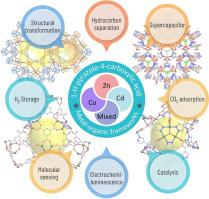Coordination Chemistry Reviews ( IF 20.3 ) Pub Date : 2023-09-19 , DOI: 10.1016/j.ccr.2023.215436
Rakesh Kumar Gupta , Parashuram Kallem , Geng-Geng Luo , Ping Cui , Zhi Wang , Fawzi Banat , Chen-Ho Tung , Di Sun

|
Metal-organic frameworks (MOFs), consisting of metal ions or clusters coordinated with organic ligands, are a class of crystalline materials that have garnered widespread prominence recently due to their unique and tunable properties, forming extended 3D frameworks with well-defined porous structures. Their exceptional chemical and structural properties have captured the attention of researchers worldwide, making them an exciting avenue for developing innovative materials with diverse applications. In particular, MOFs containing ligands with carboxylic acid and N-containing moieties hold great promise for designing novel architectures suitable for various applications. The engineered flexibility and host–guest interaction chemistry of these MOFs make them excellent candidates for pioneering materials. This review presents an inclusive summary of the latest progress in pyrazolate carboxylate MOF design, focusing on their applications in sensing, catalysis, drug delivery, and luminescence. We also introduce the synthetic process and synergistic effects of MOFs in execution. Finally, we briefly outline the obstacles, opportunities, and implications for future development in these areas.
中文翻译:

1H-吡唑-4-羧酸基金属有机骨架:多面材料
金属有机框架(MOF)由与有机配体配位的金属离子或簇组成,是一类晶体材料,由于其独特和可调的特性,近年来受到广泛关注,形成具有明确多孔结构的扩展3D框架。它们卓越的化学和结构特性引起了全世界研究人员的关注,使它们成为开发具有多种应用的创新材料的令人兴奋的途径。特别是,含有带有羧酸和含氮部分的配体的MOF对于设计适合各种应用的新型结构具有巨大的前景。这些 MOF 的工程灵活性和主客体相互作用化学使其成为先锋材料的绝佳候选者。本综述对吡唑酯羧酸酯 MOF 设计的最新进展进行了全面总结,重点关注其在传感、催化、药物输送和发光方面的应用。我们还介绍了MOFs的合成过程和执行中的协同效应。最后,我们简要概述了这些领域未来发展的障碍、机遇和影响。

































 京公网安备 11010802027423号
京公网安备 11010802027423号